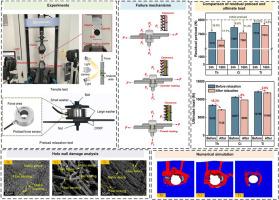一种新型螺纹插入式增强连接,实现CFRP螺栓连接的超高性能
IF 14.2
1区 材料科学
Q1 ENGINEERING, MULTIDISCIPLINARY
引用次数: 0
摘要
本文提出了一种新型的螺纹插入式增强连接,旨在实现CFRP螺栓连接的超高性能。与传统的通孔和圆柱嵌片增强节点相比,该创新设计显著提高了节点的承载能力和刚度,仿真结果通过准确预测应力分布和破坏趋势,验证了其结构优化效果。其性能的核心在于独特的加固机制:它将原始的剪切破坏和拉伸破坏模式转变为挤压破坏,这是一个关键的转变,即使在材料遭受破坏的情况下,也能使接头承受额外的拉伸载荷。实验结果表明,该接头的强度提高了44.5%,刚度提高了36.2%。螺纹插入增强接头作为该接头的关键部件,具有多种性能优势;对孔壁的微观形貌观察表明,柱形嵌套增强接头和常规通孔接头存在大规模的基体开裂,暴露出大量的基体碎片,纤维弯曲明显,而螺纹嵌套增强接头只有轻微的基体破坏和有限的纤维扭结或断裂,有效地降低了孔周向应变,提高了接头的强度、刚度、和能量吸收能力。同时,该节理具有良好的预紧稳定性,其24h预紧松弛率为2.8%,168 h预紧松弛率为4.8%,远低于通孔节理的10.9%和17.7%,即使经过预紧松弛,其强度也仅下降2.6%,远低于通孔节理的18.3%,表现出优异的长期性能稳定性。本文章由计算机程序翻译,如有差异,请以英文原文为准。

A new threaded insert reinforced joint to achieve ultra-high performance of CFRP bolted connections
This paper proposes a novel threaded insert reinforced joint, aiming to achieve ultra-high performance in CFRP bolted connections. Compared with the conventional through-hole and cylindrical insert reinforced joints, this innovative design significantly enhances load-bearing capacity and stiffness, with simulation results validating its structural optimization effect by accurately predicting stress distribution and failure trends. At the core of its performance lies a unique reinforcement mechanism: it transforms the original shear failure and tensile failure modes into extrusion failure, a critical shift that enables the joint to sustain additional tensile loads even when the material experiences damage. Experimental results confirm that the joint increases strength by 44.5 % and stiffness by 36.2 %. The threaded insert reinforced joint, as a key component of this joint, delivers multiple performance benefits; it significantly inhibits composite damage—micro-morphological observations of the hole wall show that the cylindrical insert reinforced joint and conventional through-hole joint suffer large-scale matrix cracking, expose numerous matrix fragments, and exhibit obvious fiber bending, while the threaded insert reinforced joint only has slight matrix destruction and limited fiber kinking or breakage—and it also effectively reduces hole circumferential strain and enhances joint strength, stiffness, and energy absorption capacity. Moreover, the joint excels in preload stability: its 24-h preload relaxation rate is 2.8 % and 168-h rate is 4.8 %, far lower than the through-hole joint's 10.9 % and 17.7 %, and even after preload relaxation, its strength decreases by only 2.6 %, much less than the 18.3 % reduction of the through-hole joint, demonstrating exceptional long-term performance stability.
求助全文
通过发布文献求助,成功后即可免费获取论文全文。
去求助
来源期刊

Composites Part B: Engineering
工程技术-材料科学:复合
CiteScore
24.40
自引率
11.50%
发文量
784
审稿时长
21 days
期刊介绍:
Composites Part B: Engineering is a journal that publishes impactful research of high quality on composite materials. This research is supported by fundamental mechanics and materials science and engineering approaches. The targeted research can cover a wide range of length scales, ranging from nano to micro and meso, and even to the full product and structure level. The journal specifically focuses on engineering applications that involve high performance composites. These applications can range from low volume and high cost to high volume and low cost composite development.
The main goal of the journal is to provide a platform for the prompt publication of original and high quality research. The emphasis is on design, development, modeling, validation, and manufacturing of engineering details and concepts. The journal welcomes both basic research papers and proposals for review articles. Authors are encouraged to address challenges across various application areas. These areas include, but are not limited to, aerospace, automotive, and other surface transportation. The journal also covers energy-related applications, with a focus on renewable energy. Other application areas include infrastructure, off-shore and maritime projects, health care technology, and recreational products.
 求助内容:
求助内容: 应助结果提醒方式:
应助结果提醒方式:


